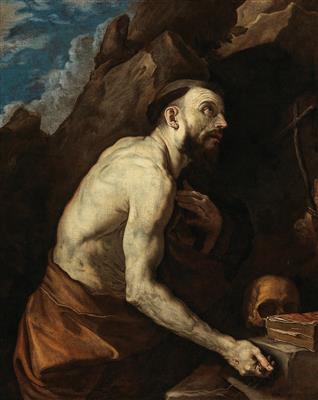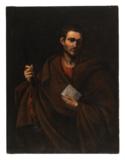Jusepe de Ribera

(Játiva 1591–1652 Naples)
The Penitent Saint Dominic,
oil on canvas, 118 x 95 cm, framed
Provenance:
Aristocratic collection, Madrid;
where acquired by the present owner, 2016
Literature:
N. Spinosa, Ribera: la obra completa, Madrid 2008, p. 446 cat. no. A291 (as Jusepe de Ribera);
N. Spinosa, La revólucion de Ribera. Los últimos descubruimientos, in: Ars Magazine, 2008, p. 114, illustrated p. 115 (as Jusepe de Ribera);
N. Spinosa, Pittura del Seicento a Napoli. Da Caravaggio a Massimo Stanzione, Naples 2010, pp. 374-375, cat. no. 373 (as Jusepe de Ribera)
We are grateful to Gianni Papi for his help in cataloguing this lot.
Saint Dominic is here represented bear chested, in penitence in front of the crucifix. Placed on the rocky ledge beside him are a skull and a book, alluding to Saint Dominic’s attribution of wisdom. The saint can be identified also by his hair, which has been cut in a tonsure, although he does not wear the typical black and white habit of the Dominicans.
In the present painting, however, the saint is with stigmata wounds which is unusal, especially when compared to the other images of the penitent Saint Dominic, such as the one by Luis Tristán in the Museo del Greco in Toledo. It is possibly an invention of the artist, who incorporates the iconography of Saint Francis with the stigmata, as well as the iconography of Saint Jerome in the desert and Saint Dominic with the tonsure. This could demonstrate that the present painting composition is not a standardised image and here Ribera created something new. Nicola Spinosa considers this painting to be a mature work by Ribera and has advanced a date after 1640.
Three-quarter length, portrait-like representations of saints were an important part of Ribera’s production: they evidently suited the sober, counter-reformation spirituality of his Spanish and Neapolitan patrons. This Saint Dominic is remarkable within this larger group of work, not only as a forceful single figure, but also because of its implication of spiritual dialogue.
The quality of the painting and its composition can be compared to at least two other works of this period: the Santa Maria Egiziaca in the Musée Fabre, Montpellier (inv. no. 837.1.27) which is signed and dated 1641 and the Saint Paul the Hermit of the Prado, Madrid. The present painting belongs to part of the stylistically consistent group of half-length saints painted by Ribera during the 1640s, including the Saint Jerome in his study from a private collection, which is signed and dated 1642 (see Spinosa 2010, cat. no. 374). Traversing the scene diagonally behind Saint Dominic, is a tree trunk on which the bark is lifting in a manner that occurs in other paintings by Ribera, including those of his earlier period, such as the Martyrdom of Saint Bartholomew from a private collection dated to 1609-1610.
At the time when the present painting was executed, Ribera’s reputation was already well consolidated in Naples. Here the artist explores his roots in the ‘tenebrist’ tradition to create a work of drama, articulated through contrasts of light and shade. Like many artists who had seen the work of Caravaggio in Rome or Naples, Ribera was struck by his technique and experimented with radiant light to create contrasts of chiaroscuro. However, he was never a direct follower of Caravaggio, but rather broadened the latter’s notion of nature, to develop his own characteristic brand of brutally visceral realism of essentially Spanish declination.
Jusepe de Ribera’s career exemplifies the international character of Baroque painting, and especially of the realist tradition. Born in Spain, Ribera traveled to Italy as a young man. In Rome from about 1613 to 1616, he developed a personal style that was significantly informed by the work of Caravaggio. During the 1630s he was influenced by artists such as Antony van Dyck and Guido Reni, while he perfected his style in the wake of his crucial meeting with Velazquez in Naples. In the 1640s Ribera made a marked return to his early, dark compositional style, abandoning the luminous pallet he had assimilated from Reni.
Expert: Mark MacDonnell
 Mark MacDonnell
Mark MacDonnell
+43 1 515 60 403
oldmasters@dorotheum.com
09.06.2020 - 16:00
- Odhadní cena:
-
EUR 300.000,- do EUR 400.000,-
Jusepe de Ribera
(Játiva 1591–1652 Naples)
The Penitent Saint Dominic,
oil on canvas, 118 x 95 cm, framed
Provenance:
Aristocratic collection, Madrid;
where acquired by the present owner, 2016
Literature:
N. Spinosa, Ribera: la obra completa, Madrid 2008, p. 446 cat. no. A291 (as Jusepe de Ribera);
N. Spinosa, La revólucion de Ribera. Los últimos descubruimientos, in: Ars Magazine, 2008, p. 114, illustrated p. 115 (as Jusepe de Ribera);
N. Spinosa, Pittura del Seicento a Napoli. Da Caravaggio a Massimo Stanzione, Naples 2010, pp. 374-375, cat. no. 373 (as Jusepe de Ribera)
We are grateful to Gianni Papi for his help in cataloguing this lot.
Saint Dominic is here represented bear chested, in penitence in front of the crucifix. Placed on the rocky ledge beside him are a skull and a book, alluding to Saint Dominic’s attribution of wisdom. The saint can be identified also by his hair, which has been cut in a tonsure, although he does not wear the typical black and white habit of the Dominicans.
In the present painting, however, the saint is with stigmata wounds which is unusal, especially when compared to the other images of the penitent Saint Dominic, such as the one by Luis Tristán in the Museo del Greco in Toledo. It is possibly an invention of the artist, who incorporates the iconography of Saint Francis with the stigmata, as well as the iconography of Saint Jerome in the desert and Saint Dominic with the tonsure. This could demonstrate that the present painting composition is not a standardised image and here Ribera created something new. Nicola Spinosa considers this painting to be a mature work by Ribera and has advanced a date after 1640.
Three-quarter length, portrait-like representations of saints were an important part of Ribera’s production: they evidently suited the sober, counter-reformation spirituality of his Spanish and Neapolitan patrons. This Saint Dominic is remarkable within this larger group of work, not only as a forceful single figure, but also because of its implication of spiritual dialogue.
The quality of the painting and its composition can be compared to at least two other works of this period: the Santa Maria Egiziaca in the Musée Fabre, Montpellier (inv. no. 837.1.27) which is signed and dated 1641 and the Saint Paul the Hermit of the Prado, Madrid. The present painting belongs to part of the stylistically consistent group of half-length saints painted by Ribera during the 1640s, including the Saint Jerome in his study from a private collection, which is signed and dated 1642 (see Spinosa 2010, cat. no. 374). Traversing the scene diagonally behind Saint Dominic, is a tree trunk on which the bark is lifting in a manner that occurs in other paintings by Ribera, including those of his earlier period, such as the Martyrdom of Saint Bartholomew from a private collection dated to 1609-1610.
At the time when the present painting was executed, Ribera’s reputation was already well consolidated in Naples. Here the artist explores his roots in the ‘tenebrist’ tradition to create a work of drama, articulated through contrasts of light and shade. Like many artists who had seen the work of Caravaggio in Rome or Naples, Ribera was struck by his technique and experimented with radiant light to create contrasts of chiaroscuro. However, he was never a direct follower of Caravaggio, but rather broadened the latter’s notion of nature, to develop his own characteristic brand of brutally visceral realism of essentially Spanish declination.
Jusepe de Ribera’s career exemplifies the international character of Baroque painting, and especially of the realist tradition. Born in Spain, Ribera traveled to Italy as a young man. In Rome from about 1613 to 1616, he developed a personal style that was significantly informed by the work of Caravaggio. During the 1630s he was influenced by artists such as Antony van Dyck and Guido Reni, while he perfected his style in the wake of his crucial meeting with Velazquez in Naples. In the 1640s Ribera made a marked return to his early, dark compositional style, abandoning the luminous pallet he had assimilated from Reni.
Expert: Mark MacDonnell
 Mark MacDonnell
Mark MacDonnell
+43 1 515 60 403
oldmasters@dorotheum.com
|
Horká linka kupujících
Po-Pá: 10.00 - 17.00
old.masters@dorotheum.at +43 1 515 60 403 |
| Aukce: | Obrazy starých mistrů |
| Typ aukce: | Salónní aukce |
| Datum: | 09.06.2020 - 16:00 |
| Místo konání aukce: | Wien | Palais Dorotheum |
| Prohlídka: | 02.06. - 09.06.2020 |

